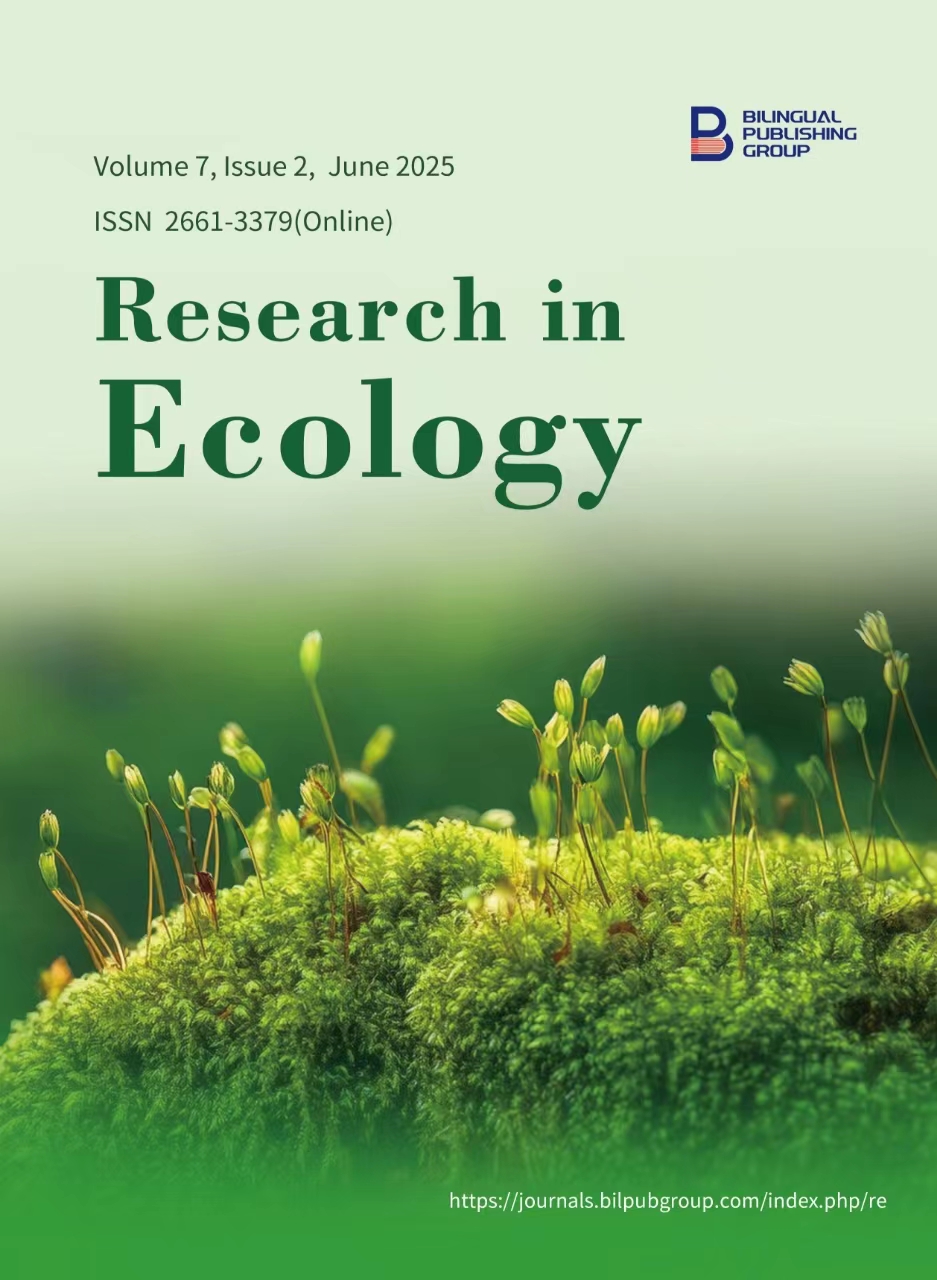
Impact of Iron Nanoparticles, Carbon Nanotube, and Biostimulatory Agents Application on Mushroom (Agaricus bisporus)
DOI:
https://doi.org/10.30564/re.v7i2.9399Abstract
Enhancing A. bisporus L. culture media with nanomaterials and some biostimulants is important for in improving mushroom productivity quantitatively and qualitatively. Magnetic iron nanoparticles (N-FeO), carbon nanotube (CNTs) suspensions, effective microorganisms (EM) bio-fertilisers, and growth stimulants (Atonik) were used individually and in combination to enhance the compost culture media. Quantitative and qualitative traits of the mushroom yield were measured. In a simple oOne-Wway experiment that included 16 treatments —Ssingle agents, two-, three-, and four-way Ccombinations and three replications—, the statistical analysis results of Duncan’'s test showed. Tthat the individual impact of the applied study treatments and their combined synergistic effects resulted in a significant increase in the traits of the number of fruiting bodies, fruiting body rate, yield quantity, mushroom biological efficiency ratio, stem length, stem diameter, head diameter, head thickness, carbohydrates content, protein content, ash, and dry matter. The application of Atonik itself resulted in the highest values of fruiting body number, yield, biological efficiency, and stem length, which were respectively were 128.33 body bags–1, 2814 g bag–1, 37.52%, and 3.03 cm, compared to the control of 32.33 body bags–1, 749 g bag–1, 9.98%, and 1.72 cm. The treatments N-FeO+CNT+EM+ATO resulted in a significant increase in the traits of the fruiting body rate, stem length, and carbohydrate content by 32.69 g, 3.40 cm, and 16.78%, respectively, compared to the control of 22.97 g, 1.72 cm, and 8.16%, respectively.
Keywords:
Agaricus bisporus L.; Compost; Bio-Fertilizer; Growth Enhancers; Iron Nanoparticles; Carbon NanotubesReferences
[1] Almjalawi, B.S.A., Chechan, R.A., Alhesnawi, A.S.M., 2024. Some applications of hericium erinaceus mushrooms: A review. South Asian Research Journal of Agriculture and Fisheries. 6(5), 92–100.
[2] Pandey, V.V., Kumari, A., Kumar, M., et al., 2018. Mushroom cultivation: Substantial key to food security. Journal of Applied and Natural. 10(4), 1325–1331.
[3] Thakur, M.P.. 2020. Advances in mushroom production: Key to food, nutritional and employment security: A review. Indian Phytopathology. 73, 377–395.
[4] Chang, S.T., Wasser, S.P., 2017. The cultivation and environmental impact of mushrooms. Available from: https://oxfordre.com/environmentalscience/view/10.1093/acrefore/9780199389414.001.0001/acrefore-9780199389414-e-231.(29 March 2017)
[5] Sahib, R.S., Shafiq, S.A., Chechan, R.A., 2022. Optimal conditions for the production of mother culture for cultivated Iraqi edible mushroom Lentinula edodes RSR strain (Shiitake mushroom). Arab Journal of Plant Protection. 40(4), 356–361. DOI: https://doi.org/10.22268/AJPP-40.4.356361
[6] Almjalawi, B.S.A., Chechan, R.A., AL-Hadedee, L.T., 2023. Food residues (potato peels) are used as an alternative to potato dextrose agar to grow edible food fungi. Journal of Applied and Natural Science. 15(1), 211–219. DOI: https://doi.org/10.31018/jans.v15i1.3989
[7] Rathore, H., Prasad, S., Sharma, S., 2017. Mushroom nutraceuticals for improved nutrition and better human health: A review. PharmaNutrition. 5(2), 35–46.
[8] Bell, V., Silva, C.R.P.G., Guina, J., et al., 2022. Mushrooms as future generation healthy foods. Frontiers in Nutrition. 9, 1050099.
[9] Farhan, E.M., Chechan, R.A., 2020. Evaluating the ability of Pleurotus ostreatus aqueous extract to modulate genotoxicity induced by cyclophosphamide in mice bone marrow cells. Iraqi Journal of Agricultural Science. 51(5), 1405–1412.
[10] Farhan, E.M., Chechan, R.A., 2023. Production of food mushrooms (Lentinula edodes) isolated from the Iraqi environment using agricultural waste. IOP Conference Series: Earth and Environmental Science. 1158(11), 112024. .
[11] Bulgari, R., Franzoni, G., Ferrante, A., 2019. Biostimulants application in horticultural crops under abiotic stress conditions. Agronomy. 9(6), 306.
[12] Boddula, R., Singh, J., Jairam, T., 2024. Exploring the different anisotropic chirality-based carbon nanotubes and their organic/inorganic composites in rotten crop toxin sensing, prevention, and shelf-life expansion. In: Biswas, K., Mohanta, Y.K., Saravanan, M., et al. (eds.). Carbon-Based Nanomaterials in Biosystems. Academic Press.: New York, NY, USA. pp. 269–297.
[13] Abdallah, M.M.S., Younis, A.E.S.M., Bakry, B.A., et al., 2020. Potential impacts of carbon tube and silicon oxide nanoparticles on growth, yield and antioxidant system of the soybean plant. Asian Journal of Plant Sciences. 19, 495–507.
[14] Tombuloglu, G., Tombuloglu, H., Slimani, Y., et al., 2024. Effects of foliar iron oxide nanoparticles (Fe3O4) application on photosynthetic parameters, distribution of mineral elements, magnetic behaviour, and photosynthetic genes in tomato (Solanum lycopersicum var. cerasiforme) plants. Plant Physiology and Biochemistry. 210, 108616.
[15] Osman, A.I., Zhang, Y., Farghali, M., et al., 2024. Synthesis of green nanoparticles for energy, biomedical, environmental, agricultural, and food applications: A review. Environmental Chemistry Letters. 22(2), 841–887
[16] Prerna, D.I., Govindaraju, K., Tamilselvan, S., et al., 2021. Influence of nanoscale micro-nutrient α-Fe2O3 on seed germination, seedling growth, translocation, physiological effects and yield of rice (Oryza sativa) and maize (Zea mays). Plant Physiology and Biochemistry. 162, 564–580.
[17] Francesca, S., Arena, C., Hay Mele, B., et al., 2020. Using a plant-based biostimulant improves plant performance and fruit quality in tomato plants grown at elevated temperatures. Agronomy. 10(3), 363.
[18] Bulgari, R., Franzoni, G., Ferrante, A., 2019. Biostimulants application in horticultural crops under abiotic stress conditions. Agronomy. 9(6), 306.
[19] Munir, N., Xiang, T.C., Bhuyar, P., et al., 2021. Effective microbes (EM) and their potential for mushroom commercialization in Malaysia. Maejo International Journal of Energy and Environmental Communication. 3(3), 45–55.
[20] Geng, J., He, S., Zhang, S., et al., 2024. Impact of incorporating shiitake mushrooms (Lentinula edodes) on microbial community and flavor volatiles in traditional Jiuqu. Foods. 13(7), 1019.
[21] Dias, E.S., Zied, D.C., Pardo-Gimenez, A., 2021. Revisiting the casing layer: Casing materials and management in Agaricus mushroom cultivation. Ciência e Agrotecnologia. 45, e0001R21.
[22] Beyer, D.M., 2017. Basic procedures for Agaricus mushroom growing. The Pennsylvania State University: University Park, PA, USA.
[23] Royse, D.J., 2014. A Global Perspective on the High Five: Agaricus, Pleurotus, Lentinula, Auricularia, and Flammulina. Proceedings of the 8th International Conference on Mushroom Biology and Products; November 19–22 2014; New Delhi, India. pp. 1–6.
[24] Page, A.L., 1982. Chemical and Microbiological Properties, 2nd ed., American Society of Agronomy Inco.: Madison, WI, USA.
[25] van Dijk, D., Houba, V.J.G., 2000. Homogeneity and stability of material distributed within the wageningen evaluating programmes for analytical laboratories commun. Soil Science and Plant Analysis. 31(11–14), 1745–1756.
[26] Zakaria, Z., Xiong, G.S., Salleh, N.H.M., et al., 2025. Simple ration formulation for carbon and nitrogen determination in mushroom cultivation material using pearson square method. AIP Conference Proceedings. 3275(1), 040006.
[27] APHA (American Public Health Association), 2017. Standard Methods for the Examination of Water and Wastewater, 23th ed. American Public Health Association: Washington DC, USA.
[28] Chapman, H.D., Pratt, P.F., 1961. Methods of analysis for soils, plants and waters. Soil Science Society of America Journal. 27(1), 60–61, 150–179.
[29] Wang, L., Xie, S., Wang, Z., et al., 2020. Functionalized helical fibre bundles of carbon nanotubes as electrochemical sensors for long-term in vivo monitoring of multiple disease biomarkers. Nature Biomedical Engineering. 4(2), 159–171.
[30] Kadochkin, A.S., Moiseev, S.G., Svetukhin, V.V., et al., 2022. Excitation of ultraslow high‐q surface plasmon polariton modes in dense arrays of double‐walled carbon nanotubes. Annalen der Physik. 534(4), 2100438.
[31] Diver, S., 2001. Nature Farming and Effective Microorganisms. Available from: https://doi.org/10.31018/jans.v14iSI.3598 (cited 10 March 2023).
[32] Kiełtyka-Dadasiewicz, A., 2010. The effect of Atonik AL application on growth and development of motherwort (Leonurus cardiaca L.) depends on plant age. Polish Journal of Agronomy. 2, 30–32.
[33] Chang, S.T., Quimio, T.H., 1982. Tropical mushrooms: Biological Nature and Cultivation Methods. Chinese University Press: Hong Kong.
[34] Joslyn, M.A., 1970. Methods in Food Analysis, Physical, Chemical and Instrumental Methods of Analysis, 2nd ed. Academic Press: New York, NY, USA & London, UK. pp. 1–845.
[35] Pardo, A., de Juan, A., Alvarez-Ortí, M., et al., 2010. Screening of Agaricus bisporus (Lange, Imbach) strains and the casing variables for quality mushroom production in Spain. HortScience. 45(2), 231–235.
[36] Mami, Y., Peyvast, G., Ghasemnezhad, M., et al., 2013. Supplementation at casing to improve yield and quality of white button mushroom. Agricultural Sciences. 4(1), 27–33.
[37] Al-Rawi, K.M., Allah, A.A.M.K., 1980. Design and Analysis of Agricultural Experiments. Dar Al-Kutub for Printing and Publishing: University of Mosul, Ministry of Higher Education and Scientific Research, Iraq.
[38] Geng, Y., Wang, Y., Li, H., et al., 2024. Optimization of manure-based substrate preparation to reduce nutrient losses and improve quality for growth of Agaricus bisporus. Agriculture. 14(10), 1833.
[39] Ahmadi-Majd, M., Mousavi-Fard, S., Rezaei Nejad, A., et al., 2022. Carbon nanotubes in the holding solution stimulate flower opening and prolong vase life incarnation—chemical and Biological Technologies in Agriculture. 9(1), 15.
[40] Soni, R., 2024. Nanotechnology in agriculture: Enhancing crop productivity with sustainable nano-fertilizers and nano-biofertilizers. Journal of Soil Science and Plant Nutrition. 24, 1–34.
[41] Hu, Y., Zhang, P., Zhang, X., et al., 2021. Multi-wall carbon nanotubes promote the growth of maize (Zea mays) by regulating carbon and nitrogen metabolism in leaves. Journal of Agricultural and Food Chemistry. 69(17), 4981–4991.
[42] Arion, L.D., Truta, A.M., Rebrean, F.A., et al., 2024. Influence of geographical provenance, biostimulatory treatments and their interaction on the seed germination of Quercus robur L. Nova Geodesia. 4(4), 217.
[43] Al-Qaisi, A.A.D., Altai, S.H., 2023. The effect of inoculation with mycorrhiza fungi and organic fertilization on the content of plant nutrient-absorbing and heavy elements of chrysanthemum Calendula officinalis L. IOP Conference Series: Earth and Environmental Science. 1262(8), 082020.
[44] Al-Zayadi, A.M., Jarallah, R.S., 2025. Effect of bioinoculum and crop waste at the concentration of N, P, K and the sustainability of natural resources in soil planted with wheat. IOP Conference Series: Earth and Environmental Science. 1449(1), 012109.
[45] Al-Shahmani, A.M.K., Al-Juthery, H.W.A., 2021. Response of rice (Oryza sativa L.) to silica fertilization and spraying with nano-potassium and calcium. IOP Conference Series: Earth and Environmental Science. 735(1), 012068.
[46] Al-Zayadi, A.M., Jarallah, R.S., 2023. Impact of fertilizer type and vegetative growth duration on the availability of copper in clay loam soil planted with maize (Zea mays L.) in Iraq. IOP Conference Series: Earth and Environmental Science. 1259, 012002.
[47] Forstner, C., Orton, T.G., Wang, P., et al., 2019. Effects of carbon nanotubes and derivatives of graphene oxide on soil bacterial diversity. Science of the Total Environment. 682, 356–363.
[48] Al–Badiri, Z.K., Al-Juthery, H.W., 2022. Effect of spraying some bio-and nano-stimulants fortified with potassium on the growth and yield of rice. IOP Conference Series: Earth and Environmental Science. 1060(1), 012036.
[49] Ola, H.R., Al-Juthery, H.W.A., 2025. Effect of nano-manganese, EM. bokashi fertilization and spraying nanoparticles of iron and carbon nanotubes in soil sustainability, enhancing some growth parameters and yield of broccoli. IOP Conference Series: Earth and Environmental Science. 1449(1), 012106.
[50] Yan, L., Li, P., Zhao, X., et al., 2020. Physiological and metabolic responses of maize (Zea mays) plants to Fe3O4 nanoparticles. Science of the Total Environment. 718, 137400.
[51] Deng, C., Tang, Q., Yang, Z., et al., 2022. Effects of iron oxide nanoparticles on phenotype and metabolite changes in hemp clones (Cannabis sativa L.). Frontiers of Environmental Science & Engineering. 16(10), 134.
[52] Al-Karaawi, M.D.K., Al-Juthery, H.W.A., 2024. Effect of selenium, nano vanadium spraying, and NPK fertilizer source on rice grains’ qualitative traits and active substances. AIP Conference Proceedings. 3079(1), 32-44.
[53] Rashid, O.H., Al-Juthery, H.W.A., 2025. Effect of spraying nano elements and EM. Bokashi on broccoli crop quality contents of active constituents. IOP Conference Series: Earth and Environmental Science. 1449(1), 012104.
[54] Rajput, A., Kumar, S., Dhyani, B. P., Kumar, Y., Singh, A., & Singh, B. (2024). ENHANCING YIELD AND SUSTAINABILITY IN A MAIZE+ MUNGBEAN-WHEAT CROPPING SEQUENCE THROUGH INTEGRATED NUTRIENT MANAGEMENT: A VIABLE ALTERNATIVE TO THE RICE-WHEAT SYSTEM. Plant Archives (09725210), 24(2).
[55] Safdar, M., Kim, W., Park, S., et al., 2022. Engineering plants with carbon nanotubes: A sustainable agriculture approach. Journal of Nanobiotechnology. 20(1), 275.
[56] Kizilbash, N., Alruwaili, J., Hai, A., et al., 2020. Water soluble carbon nanotubes increase agricultural yields. Journal of Biochemical Technology. 3(1), 1–4. DOI: https://doi.org/10.1007/s11104-022-05852-0
[57] Jaafer, A. A., Mohammed, R. J., & Hassan, D. F. (2020). Studying the thermodynamic parameters for the evaluation of potassium availability by adding organic matter. Biochemical & Cellular Archives, 20(1).
Downloads
How to Cite
Issue
Article Type
License
Copyright © 2025 Mustafa Algarawi, Hayyawi A. W. Al-Juthery, Rukaibaa A. Chechan

This is an open access article under the Creative Commons Attribution-NonCommercial 4.0 International (CC BY-NC 4.0) License.




 Mustafa Algarawi
Mustafa Algarawi






